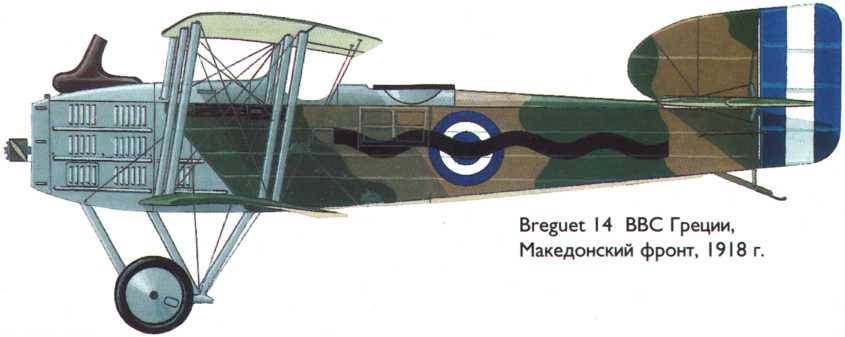В.Кондратьев Самолеты первой мировой войны
БРЕГЕ 14 / BREGUET 14
Двухместный биплан с мощным V-образным двигателем жидкостного охлаждения. Разработан в конце 1916 известным французским инженером и предпринимателем Луи Бреге. Конструкция машины очень перспективна для своего времени. В силовом наборе преобладал дюраль. Обшивка передней части фюзеляжа - профилированные алюминиевые листы, остального - полотно. Вдоль всей задней кромки нижнего крыла навешивались посадочные щитки-закрылки.
Первый полет состоялся 15 апреля 1917. Испытания прошли успешно, и уже в мае налажено серийное производство. Массовый выпуск продолжался до 1926 г. Всего построено более 8000 машин. Большинство из них двух модификаций: "Бреге 14" A.2 - разведчик и "Бреге 14" B.2 - бомбардировщик. Разведчики комплектовались аэрофотоаппаратами. Бомбардировщики отличались автоматическими бомбосбрасывателями "Мишлен" под крылом и прямоугольными иллюминаторами в бортах кабины летнаба. На многих машинах сиденья экипажа были бронированы. По мнению экспертов, "Бреге 14" заслуживает звания лучшего фронтового самолета первой мировой войны. Высокие летные и боевые данные позволяли применять его в любой обстановке без истребительного прикрытия. На заключительном этапе войны "четырнадцатые" состояли на вооружении 55 французских и 2 бельгийских эскадрилий западного фронта, которые сбросили на врага 1853 тонны бомб. 290 аппаратов передано американскому экспедиционному корпусу. "Янки" воевали на "Бреге" с июля 1918 до окончания боевых действий.
Уже в августе 1917 года, т.е. всего через два месяца после запуска в серию, "Бреге 14" обеих модификаций попали в Россию. Это опровергает распространенное мнение, что французы поставляли своим русским союзникам только устаревшие типы боевых машин. Здесь самолет получил название "Бреге с крылышками" (вероятно, имелись в виду закрылки). "Бреге" применялся на русском фронте до Брестского мира, а затем и в гражданской войне. В 1919 году около десятка машин получила армия Деникина. Четыре из них позднее были захвачены красными.
В начале 20-х "Бреге 14" активно закупали военные и гражданские организации многих стран. Он участвовал в польско-советской и греко-турецкой войнах.
ДВИГАТЕЛЬ
"Рено 12" Fcx, 300 л.с. или "Рено 12" Fcy, 310 л.с.
ВООРУЖЕНИЕ
1 синхронный "Виккерс" и 2 турельных пулемета "Льюиса". Иногда дополнительно - шкворневый пулемет в нижней люковой установке. Бомб. нагрузка "Бреге 14" В.2 - до 235 кг.
А.Шепс Самолеты Первой мировой войны. Страны Антанты
Бреге Bre.14 1916 г.
Эта машина стала лучшим французским легким бомбардировщиком Первой мировой воины. Создание нового легкого бомбардировщика для французских ВВС было вызвано необходимостью иметь самолет, способный вести боевые действия при значительном противодействии истребителей противника. Опытный самолет впервые взлетел 21 ноября 1916 года. Это был двухстоечный биплан смешанной конструкции. Каркас фюзеляжа изготавливался из металлических труб и профилей. Носовая часть закрывалась алюминиевыми панелями. Причем панели, прикрывающие двигатель, имели отверстия для его охлаждения. Задняя часть обшивалась полотном. В носовой части фюзеляжа на металлической раме устанавливался лобовой сотовый радиатор, а за ним - 12-цилиндровый, жидкостного охлаждения, рядный "Рено-12FCX" мощностью 300 л. с. Перед кабиной пилота размещались топливный и масляный баки, а за ней - кабина стрелка-наблюдателя, оборудованная турелью. Крыло самолета двухлонжеронное, оборудовалось элеронами с роговой весовой компенсацией. Лонжероны имели конструкцию из металлических профилей. Нервюры изготавливались из фанеры и деревянных брусков. Вся конструкция обшивалась полотном с тщательной проклейкой стыков. Подобную конструкцию имело и оперение самолета. Причем стабилизатор с регулируемым углом установки крепился системой растяжек и подкосов. Стойки крыла и шасси изготавливались из стальных труб, причем стойки крыла имели обтекатели из дерева. Шасси имело оригинальную конструкцию с дополнительной несущей поверхностью по оси колес. Амортизация, как обычно для того времени, шнуровая, резиновая. Следует отметить, что самолет не имел центроплана. Верхнее крыло с вырезом для обзора пилоту стыковалось по оси самолета, а нижнее - к узлам фюзеляжа. Под нижним крылом устанавливались специальные панели с бомбодержателями, обеспечивающими механический сброс бомб. Вооружение самолета кроме 235-250 кг бомб состояло из синхронного 7,69-мм пулемета "Виккерс" и двух пулеметов "Льюис" на турели у стрелка�наблюдателя. Самолет строился массовой серией в различных модификациях. До конца войны построено более 5,5 тысячи машин, а до 1926 года, когда был прекращен выпуск этих самолетов, - 8 тысяч. Около 200 самолетов были переоборудованы после войны в почтово-пассажирские. Военные Bre.14 эксплуатировались до конца 1920-х годов, а гражданские - до середины 1930-х.
Модификации
Bre. 14A2 - фронтовой разведчик, отличался от базовой модели отсутствием бомбодержателей, с двигателем "Рено" (210л. с.).
Bre. 14B1 - одноместный легкий бомбардировщик с тем же двигателем, самолет в серию не пошел из-за отсутствия защиты в задней полусфере.
Bre. 14B2 - массовая серия фронтового легкого бомбардировщика, основа для всех последующих модификаций.
Bre. 14E2 - учебный самолет на базе серийного, было снято вооружение, установлено двойное управление. Небольшая серия.
Bre. 14GR - дальний разведчик.
Bre. 14Н - гидросамолет на металлических поплавках с тем же двигателем.
Bre. 14S - санитарный самолет на базе легкого бомбардировщика, только вместо стрелка-наблюдателя в фюзеляже делалось место для лежащего раненого и откидная дверь.
Bre. 16BN2 - ночной бомбардировщик с более мощным двигателем "Рено" (360 л. с.), отличался крылом большего размаха, увеличенным килем. Элеронами оборудовалось, кроме верхнего, и нижнее крыло. Руль поворота имел весовую компенсацию.
Bre. 17C2 - двухместный истребитель на базе Bre. 14 А2, но с более мощным двигателем, усиленным вооружением, с уменьшенным размахом крыльев и элеронами, как на Бреге 14.
Bre.14T - транспортно-пассажирский и почтовый самолет на базе Bre. 14 В2 с тем же двигателем. Кабина стрелка переделывалась для перевозки людей и грузов. Машина эксплуатировалась на почтовых линиях, связывавших Францию с Танжером, Кассабланкой, Ораном и Даккаром.
Bre. 14TOE - колониальный самолет.
ЛЕТНО-ТЕХНИЧЕСКИЕ ХАРАКТЕРИСТИКИ
Bre.14A2 Bre.14B2 Bre.14T
Размах, м 14,86/13,66 14,86/13,66 14,83/13,66
Длина, м 8,87 8,87 8,87
Высота, м 3,30 3,30 3,30
Площадь крыла, кв.м 51,00 51,00 47,50
Сухой вес, кг 1140 1100 1010
Взлетный вес, кг 1740 1765 1520
Двигатель: "Рено 12 FCX" "Рено 12"
мощность, л. с. 300 300
Скорость максимальная, км/ч 180 177 180
Время набора высоты, м/мин. 3000/34
Дальность полета, км 900 900 500
Потолок, м 6000 5800 6300
Экипаж, чел. 2 2 2
Вооружение 3 пулемета 3 пулемета -
100 кг бомб 235 кг бомб
G.Swanborough, P.Bowers United States Military Aircraft Since 1909 (Putnam)
BREGUET 14
Two versions of the 1917 French Breguet 14 combined with the French Salmson 2A-2 to form the main two-seater strength of the A.E.F. until the “Liberty Planes” went into action in August 1918. The Breguet 14A-2 was a “Corps d’Armee”, an observation type, while the 14B-2 was a day bomber. The two were easily distinguishable by the longer lower wing on the B, which was also fitted with a spring-loaded full-span automatic flap that acted as a camber-changing device. Unorthodox by prevailing French standards was the bolted aluminium tube fuselage construction, but the negatively-staggered wings, generally considered unorthodox, were fairly common to several French designs. Two different power plants were used, the 6-cylinder Italian Fiat of 285 h.p. and the 300-h.p. French Renault V-12. A few Breguets sent to McCook Field for test were fitted with Liberty engines.
Data for Breguet 14A (Liberty engine): Span, 47 ft. 3 in.; length, 29 ft. 2 in.; wing area, 527 sq. ft.; empty weight, 2,392 lb.; gross weight 3,771 lb.; high speed, 129 m.p.h.
J.Forsgren Swedish Military Aircraft 1911-1926 (A Centennial Perspective on Great War Airplanes 68)
Breguet XIV A.2
Only one Breguet XIV A.2 (c/n 2030) was used by Flygkompaniet. The story behind its acquisition includes a few interesting twists and turns. In summer of 1919, the Danish-born pilot Paulli Krause-Jensen, who had served in the French Air Force during the war, made a long distance flight between Paris and Stockholm, arriving safely at Barkarby just north of the Swedish capitol. (Some sources claim that Krause-Jensen had intended to fly to Finland, but this appears to be without foundation.) On his way back to Paris, Krause-Jensen was obliged to make an emergency landing near Enkoping due to engine trouble. Some enterprising members of the local population subsequently took the opportunity to rob the engine of its copper tubes for use in moonshine distilleries. The Breguet XIV A.2 was eventually donated to Flygkompaniet, and taken on charge in October 1919.
Assigned the serial number 9100, the Breguet XIV was rarely used. The fuel system was considered overly complicated due to the installation of extra fuel tanks, with the 300 h.p. Renault engine also having a mind of its own. Struck off charge on 5 January 1923, it was put up for auction. The Breguet was acquired by AFK pilot Nils Soderberg for 1,000 kronor, who intended to use the airplane in the forthcoming ILUG arrival contest. His Breguet XIV was registered as S-AIAA, with restoration to airworthiness costing Soderberg another 1,781 kronor. Soderberg won the ILUG arrival contest, flying from Amsterdam in the Netherlands to Gothenburg. Arriving at Gothenburg on August 4, Soderberg won first prize, 10,000 kronor, also securing an additional 4,000 kronor for securing first place in the arrival contest, as well as the King’s cup. Being paid to fly military airplanes, Soderberg did not have any further need for the Breguet XIV. He managed to sell it to the Swedish Red Cross for use as spares for their Breguet XIV T, S-ASAA.
Breguet XIV A.2 Technical Data and Performance Characteristics
Engine: 1 x 300 h.p. Renault
Length: 8,86 m
Wingspan: 14,40 m
Height: 3,50 m
Wing area: 48,5 m2
Empty weight: 1,017 kg
Maximum weight: 1,900 kg
Maximum speed: 165 km/h
Armament: -
Сайт Pilots-and-planes
The Breguet 14 became, after the Nieuport and SPAD series of fighters, one of the best known French aircraft of the First World War. It was the most successful bomber developed in France during the war, and when the Breguet 14 entered service it rejuvenated the previously moribund French day bomber force.
After building a small number of BM 4 and Breguet 5 bombers, the Breguet firm had no further orders for aircraft and therefore turned to producing 100 A.R. Is under license. Further development of the Breguet-Michelin bombers was out of the question as this series had proved to be ineffective in their intended roles as day bombers and long-range fighters. Breguet realized that his next design would have to be capable of surviving the hostile environment of the Western Front.
His new design was designated the AV (which may have stood for Avant, or tractor layout). It was equipped with a Renault engine and featured a wing with low wing loading. Breguet returned to the tractor layout he had always preferred (the Breguet-Michelin bombers having been designed as pushers at the request of the Aviation Militaire). Another major innovation was the widespread use of duralumin, which had been employed in the construction of German airships. While this metal was valued for its strength and light weight, it was difficult to work with. Breguet's breakthrough was the discovery of a way to use the alloy in an aircraft intended for mass production. Duralumin was employed in the longerons and spacers inside the fuselage. The longerons and spacers were bolted into welded steel end fittings and braced with piano wire. The engine bearers were made of steel and duralumin tubing. Duralumin tubes also formed the main spars of the wings. The outer struts were reinforced with steel sheaths around the spars. The wing ribs were made of wood and the root ribs were made of poplar. The tail surfaces were of welded steel tubing.
The first prototype was the AV 1, equipped with a 263-hp Renault engine. A second prototype, the AV 2, had a 272-hp Renault, a slightly longer fuselage, and a slightly higher empty weight. Flight tests revealed that the aircraft pulled to the left and this required offsetting the vertical fin to the left. The upper wing was given a slight sweepback; improving stability and giving the rear gunner a better field of fire. After six months of design work and testing, the prototype flew on 21 November 1916. Tests were conducted initially at Villacoublay with Breguet himself at the controls. By January 1917 the initial flight trials had been completed. The tests confirmed that Breguet had produced a bomber that was, for once, more advanced than comparable machines used by the British and Germans. In November 1916 Breguet notified the STAe that the AV prototypes were ready for testing. Static tests were conducted by the STAe on 26 January 1917 and confirmed the sturdiness of Breguet's design; the wings were found to have a coefficient 5.5 times the total weight of the aircraft. The AV 2 was test-flown by Adjudant Piquet (an STAe pilot) and Lieutenant Lemaitre (a pilot from BM 120). The AV 2 was highly praised, and its usefulness in the day bomber role was readily apparent to the STAe.
In November 1916 the STAe had formulated a requirement for four types of aircraft: a two-seat army cooperation plane (A), a three-seat, long-range reconnaissance plane (A1), a two-seat fighter (C), and a three-seat bomber (D). Breguet submitted variants of the AV intended to meet all four categories. The Type A requirement would be met by the Breguet 14 A2 while the two-seat fighter would eventually be developed into the Breguet 17. The three-seat reconnaissance plane (Class A1) and bomber (Class D) version of the AV design were built and tested, but the STAe decided that aircraft in these categories should have two engines and Breguet's design was not developed further. The two-seat fighter variant with a 300-hp Renault engine was tested, but it could not meet the required speed at 3,000 in (180 km/h). Like its competitor, the SPAD 11, Breguet's design was not selected for production (although the SPAD 11 did enter service in the two-seat reconnaissance role).
The STAe had requested that the new bomber be powered by a 200-hp Hispano-Suiza engine. Breguet, instead, decided to use the 220-hp Renault 12Fb that had been the power plant for the Breguet-Michelin 5. The engine cowling had a plethora of cooling louvers, one of the distinguishing features of the Breguet 14 bombers. The Breguet 14 was an angular biplane The wings had negative stagger and both were slightly swept back. The upper wing had a greater span than the lower, and ailerons were fitted to the upper wing only. Later machines had horn-balanced ailerons to improve lateral control. The two crew members were seated in tandem. The pilot sat below a cutout in the upper wing and an observer had a separate cockpit just behind him. The observer had a T.O.3 or T.O.4 gun mount with two 0.303 Lewis guns. The pilot had a single, fixed Vickers 0.303 gun mounted on the left side of the fuselage and synchronized to fire through the propeller disc. The undercarriage was strongly braced with the two wheels being separated by a strut with an airfoil cross-section. The early versions of the Breguet 14 B2 had Michelin bomb racks under the lower wings adjacent to the bracing struts of the undercarriage. Thirty-two 11.5 kg bombs could be carried. The A2 reconnaissance versions could carry four bombs, a camera, and a wireless set. There were minor differences between the bomber (designated B2) and reconnaissance (designated A2) versions. The lower wings of the bomber version had a longer span and bungee-sprung flaps were added. These flaps enabled the B2 variants to carry heavier bomb loads; test flights revealed that the aircraft could carry 730 kg of bombs and fuel. Fully loaded, the Breguet 14 B2 could climb to 4,000 in in 26 min and could attain a speed of 165 km/h at that altitude. The observer had an extra set of windows in the fuselage sides; it has been speculated that these were intended to provide enough light to enable him to use the bombsight. There were transparent panels in the underside of the aircraft, which enabled both the pilot and observer to view the ground.
Breguet received an order for 150 Breguet AV 1s (reconnaissance) on 6 March 1917 and on the same date Michelin received an order for 150 AV 2s (bomber version). In fact, initially the STAe designated the AV I the Breguet 13 and the AV 2 the Breguet 14. Of course, the Breguet 13 designation was soon dropped and both variants received the Breguet 14 designation. An additional order for 100 aircraft was placed on 4 April, followed by 250 in July and 125 in September. The engine used was primarily the 300-hp Renault 12Fcx. Additional aircraft were built under license. These orders were placed with Darracq (330 aircraft), Farman (220), Paul Schmitt (275), Ballanger (300), and Sidam (300). It is believed that production was evenly divided between the bomber and reconnaissance versions. Serial numbers for the production Breguet 14s began at 1101 (1106 was the first aircraft delivered).
In operational service, the Breguet 14s underwent numerous modifications, including addition of a Lewis gun on the top wing, armored seats, and a gun rigged to fire underneath the fuselage. As mentioned earlier, some Breguet 14s were equipped with horn-balanced ailerons, and on the B2s this change was accompanied by deletion of the lower wing flaps and reduction in the lower wing span and wing tip size.
Variants
Breguet 14 with Fiat Engine
Due to a shortage of Renault engines, some versions of the Breguet 14 were fitted with 300hp Fiat A-12 bis engines. The first example flew in 1917 with a Fiat A-12 engine, and this Breguet 14 could be distinguished by its tapered cowling and under slung radiator. However, these changes reduced the aircraft's performance and, as a result, a modified engine, the Fiat A-12 his, was developed. This developed the same horsepower but it could be fitted to the aircraft without requiring alterations to the cowling. The Fiat engines were used in the A2, B2, and E2 (trainer) versions of the Breguet 14. The type equipped 24 Breguet 14 escadrilles, and examples were supplied to Belgium and the United States. Other examples of the Breguet 14 were fitted with the 260-hp Fiat A- 12 engine, and at least one with a 600 -hp, Fiat A- 14.
Breguet 14 Ap2
The Ap 2 specification of 1917 called for a high altitude, long-range reconnaissance aircraft. Breguet 14 B2 (serial number 4360) was modified to accept a 400-hp Liberty 12 engine. The aircraft was tested at Villacoubly. Neither it nor its competitor, the Hanriot Dupont 9, was selected by the Aviation Militaire. A similar installation was performed at McCook Field on Breguet 14 B2 AS 94097. As far as can be determined, the installation of the Liberty on the B2 did not affect performance and, had the war continued, it might have proved a useful alternative to the Renault or Fiat engines. On the Breguet 14 A2 the Liberty provided a significant performance edge over the Renault-equipped machines.
Breguet 14 with Lorraine-Dietrich Engine
A Breguet 14 A2, serial 1021, was fitted with a 285-hp Lorraine-Dietrich 8Bd engine. The installation was successful enough to warrant production; some versions of this aircraft had a blunt cowling and an under slung radiator. These were used by French T.O.E. (colonial) escadrilles and may have been designated Breguet 14TOEs, although this designation has not been confirmed. it has been reported that some were supplied to Spain; however, Spanish sources do not confirm this.
Other examples of the Breguet 14 were fitted with 370-hp Lorraine-Dietrich 12Da or 390-hp Lorraine -Dietrich 12E engines. It appears these remained one-off conversions.
Breguet 14 with Panhard Engine
A 340-hp Panhard 12D and a 350-hp Panhard 12C were each fitted experimentally to a Breguet 14 airframe. Series production did not ensue.
Breguet 14 A2 with Renault Engine
A single Breguet 14 A2 was tested with a 400-hp Renault 12k engine in May 1918. This aircraft served as the basis for the Breguet 17 escort fighter.
Other Renault engines fitted to the Breguet 14 included the 310-hp Renault 12Fcy, 320-hp Renault 12Fe, and 350-hp Renault 12Ff.
Breguet 14 AE
This aircraft was designed for use in the French colonies. It first flew in 1920 and carried the registration F-AEEZ.
Breguet 14/400
Version with a 400-hp Lorraine 12Da engine. Seventy were supplied to China and Manchuria during the 1920s.
Breguet 14 C
Version with 450-hp Renault 12Ja engine. It first flew in 1920 and was used as a postal aircraft in the United States.
Breguet 14 H
Floatplane version with 320-hp Renault 12Fe engine. it had a large central float beneath the fuselage and two smaller floats under the wings. At least two were produced and saw service with the Escadrille Indo-Chinoise No.2 based in Bien Hoa in 1925.
Breguet 14 with Supercharger
A number of Breguet 14s were modified to accept Renault 12Fe engines with the Rateau turbo -supercharger. Aircraft with the new engine were found to have a marked improvement in performance. One set a world record in 1923 by climbing to 5,600 m with a payload of 500 kg. Sixteen Breguet 14s with the turbo-supercharged engines were in service with the 34th RAO at Bourget in 1924.
Breguet 14 A2 with 49 sq. m Wing
This aircraft was developed by Breguet in the hope of meeting the STAe's requirement for a maximum speed of 180 km/h at 3,000 m. This version had a reduced wing area of 49 sq. m without the automatic flaps and a more powerful Renault 12Fcx engine.
Aircraft 665 was used for official trials. One advantage of the new type was that it could reach an altitude high enough to make it immune to anti-aircraft fire or enemy fighters. In fact, in September 1917 an altitude of 8,000 meters was reached.
Breguet 14 B1
The B1 designation indicates that this was a single-seat version of the Breguet 14 B2 with a wing area of 52 sq. m and automatic flaps. The front cockpit was fitted with fuel tanks and the pilot was relocated to the observer's position. Test pilot De Bailliencourt later tested the Breguet 14 B I intended for Jules Vedrine's raid on Berlin. While flying the aircraft he found that the Solex carburetor froze at altitude. He attempted to land in order not to risk damage to this specially modified machine, but as he descended, the engine stalled. However, he was able to bring the plane down safely. Unfortunately, the prototype of the Bleriot 71 apparently crash-landed while attempting to avoid the incoming Breguet 14 B 1.
The Breguet 14 B I could carry a 180-kg bomb load and had a duration of up to seven hours. Two were ordered and were intended to be used on a raid on Berlin. Jules Vedrines performed a test flight of 400 km (flying from Paris to Cancale ) in July 1917 in preparation for this mission. However, the overall reluctance of the French government to bomb German cities (because of the high risk of German retaliation) combined with the Breguet 14 B1's marginal range and vulnerability to enemy fighters, resulted in cancellation of the plan.
Breguet 14 Floatplane
Another floatplane version of the Breguet 14 was tested in 1924 at the Saint Raphael Center four were manufactured by Blanchard and could be used interchangeably with the regular undercarriage. At least one Breguet 14 B2 landplane was tested with floatation gear.
Breguet 14 S
The French led the world in the development of ambulance aircraft. An ambulance version of the Breguet 14 was developed to supplement, and later replace, Voisin 10 ambulance planes. These aircraft were designated Breguet 14 S (S = Sanitaire). Initially they were simply modified to carry two stretcher cases in the rear fuselage. Subsequently, a dedicated ambulance version was produced that was a modified version of the Breguet T. In 1918, four Breguet 14 S machines were used over the Aisne front. For postwar use see the section on colonial campaigns.
United States
The United States entered World War I in the belief that a powerful bombing force could shorten, if not end, the conflict. The Air Service had tremendous enthusiasm but no indigenous aircraft with which to conduct bombing raids. The decision, pending the availability of the Liberty-engined D.H.4, was for the Americans to obtain Breguet 14 bombers. The French initially promised to deliver 1,500 of these aircraft, although only 290 had been delivered by the Armistice.
The Americans initially ordered 376 of them: 100 Breguet 14 E2 trainers, 229 Breguet 14 A2s, and 47 Breguet 14 B2s. Approximately half of these had Fiat A-12 or A-12bis engines.
The first American unit to fly the aircraft operationally was the 96th Aero Squadron. Training began at the Michelin brothers testing field on 1 December 1917.
The first operational American day bombardment unit, the 96th Aero Squadron, took ten of its Breguet 14s to Amanty airfield on 18 March 1918. It has been reported that the aircraft were in poor repair and, because French supplies were often unavailable, the unit's mechanics had to make use of modified
farm machinery parts. The first mission was flown on 12 June 1918. However, the aircraft were in such poor condition that many raids had to be canceled. Because of these equipment difficulties, no American day bomber units were involved in the Chateau-Thierry campaign of July 1918. On 10 July, however, the 96th Aero Squadron had enough serviceable aircraft on strength to attempt a smaller raid. Six Breguet 14s left to bomb the railroad yards at Conflans. Unfortunately, the inexperience of the American pilots resulted in all six aircraft being captured.
Two days before the Saint Mihiel offensive, the 96th Aero Squadron was assigned to the First Day Bombardment Group. During the offensive, the 96th performed ground attack missions and bombed rail centers. Many Breguet 14s were damaged during crash landings on the muddy airfields, the 96th Aero Squadron losing 16 men and 14 planes in only five days. This was the worst loss rate of any AEF unit. The 96th was reconstituted with new crews and aircraft and was back in action in time for the Meuse-Argonne offensive. Due to bad weather the 96th Aero Squadron was able to fly only two days in November.
The other units of the First Day Bombardment Group used Liberty-engined D.H.4s; however, it was widely believed that the Breguet 14 was the superior bomber. The Gorrel Report notes that the Breguet 14s were faster at altitude, carried a heavier load, had excellent defensive armament, had a protected upper fuel tank and a droppable lower tank, were equipped with the excellent Michelin bomb racks, and that "no stronger ship has probably ever been subjected to hard active service and given such excellent results."
While the 96th Aero Squadron saw the main use of the Breguet 14, the 9th Night Reconnaissance Squadron also used the reconnaissance version. These were employed for day observation as well as night reconnaissance and attack missions, the latter with mixed results. The unit operated over the Toul sector from 30 August to I I September and took part in the Saint Mihiel and Meuse-Argonne offensives. The 99th Corps Observation Squadron also had Breguet 14s on strength for a brief time.
Breguet AV I Two-Seat Reconnaissance Plane with 263-hp Renault
Span 14.36 m
Length 8.80 m
Wing area 50.0 sq. m
Empty weight 1,015 kg
Loaded weight 1,525 kg
Max speed
ground level 179 km/h
Breguet AV 2 Two-Seat Reconnaissance Plane with 272-hp Renault
Span 14.36 m
Length 8.90 m
Wing area 52.0 sq. m
Empty weight 1,020 kg
Loaded weight 1,530 kg.
Max speed
ground level 181 km/h
2000 m 172 km/h
5,000 m 165 km/h
Breguet 14 A2 Two-Seat Reconnaissance Plane with 300-hp Renault 12Fcx
Span 14,364 m (without horn balances)
14.860 m (with horn balances)
Length 8.870 m.
Height 3.330 m
wing area 47.5 sq, m (without horn balances)
49.2 sq. m (with horn balances)
Empty weight 1,030 kg
Loaded weight 1,565 kg
Max speed
4,000 m 184 km/h
Climb to
2,000 m 6 minutes 50 seconds
3,000 m 11 minutes 35 seconds
5,000 m 29 minutes 30 seconds
Ceiling 6,100 m
Endurance 2.75 hours
Armament One synchronized 7.7-mm Vickers machine gun,
two 7.7-mm Lewis machine guns on a T.O.3 or T.O.4 ring mount,
four 120-mm bombs.
Breguet 14 A2 Two-Seat Bomber with 300-hp Renault 12Fcx
Span 14.364 m (without horn balances)
14.860 m (with horn balances)
Length 8.870 m
Height 3.330 m
Wing area 50.2 sq.m. (without horn balances)
48.5 sq. m (with horn balances)
Empty weight 1,017 kg
Loaded weight 1,769 kg, bomb load 355 kg.
Max speed 195 km/h
Climb to
2,000 m 9 minutes 15 seconds
3,000 m 16 minutes 30 seconds
5,000 m 47 minutes
Ceiling 6,200m
Endurance 2.75 hours
Armament one synchronized 7.7-mm Vickers machine gun,
two 7.7-mm Lewis machine guns on a T.O.3 or T.O.4 ring mount,
one 7.7-mm Lewis machine gun firing through the floor of the aircraft on some B2s,
32 115-mm bombs or equivalent load
Breguet 14 A2 Two-Seat Reconnaissance Plane with 310-hp Renault 12Fcy
Empty weight 1,040 kg
Loaded weight 1,915 kg
Bomb load 300 kg
Max speed 195 km/h
Climb to
2,000 m 7 minutes 40 seconds
3,000 m 12 minutes 10 seconds
5,000 m 25 minutes 40 seconds
Ceiling 5,200m
Endurance 2.75 hours
Armament one synchronized 7.7-mm Vickers machine gun,
two 7.7-mm Lewis machine guns on a T,O.3 or T.O.4 ring mount,
four 120-mm bombs.
Breguet 14 A2 Two-Seat Reconnaissance Plane with Renault 12Fe with Rateau Turbo Supercharger.
Max speed 184 km/h at 3,000 m
Climb to
2,000 m 10 minutes 1 second
3,000 m 14 minutes 57 seconds
5,000 m 28 minutes l6 seconds
Endurance 3.0 hours
Breguet 14 A2 Two-Seat Reconnaissance Plane with 400-hp Renault 12K
Empty weight 1,2102 kg
Loaded weight 1,859 kg; bomb load 185 kg
Max speed 203 km/h at 2,000 m
Climb to
2,000 m 6 minutes 9 seconds
3,000 m 10 minutes 19 seconds
5,000 m 22 minutes 28 seconds
Ceiling 7,600 m
Endurance 3 hours 4 minutes
Breguet 14 A2 Two-Seat Reconnaissance Plane with 300-hp Fiat A-12 bis
Empty weight 1,160 kg
Loaded weight 1,698 kg
Max speed 167 km/h at 2,000 m
Climb to
2,000 m 11 min. 45 sec
3,000 m 19 min. 28 sec.
Ceiling 5000 m
Endurance 3.0 hours
Breguet 14 A2 Two-Seat Reconnaissance Plane with 285-hp Lorraine-Dietrich 8Bd
Empty weight 1,160 kg
Loaded weight 1,476 kg
Max speed 104 mph at 2,000 m
Climb to
2,000 m 9 minutes 26 seconds
3,000 m 15 minutes 11 seconds
5,000 m 43 minutes 6 seconds
Ceiling 5,600 m
Endurance 3.0 hours
Breguet 14 A2 Two-Seat Reconnaissance Plane with -370-hR Lorraine-Dietrich 12Da
Max speed 195 km/h at 2,000 m
Climb to
2,000 m 5 minutes 20 seconds
3,000 m 8 minutes 50 seconds
5,000 m 19 minutes 20 seconds
Ceiling 7,600 m
Breguet 14 A2 Two-Seat Reconnaissance Plane with 400-hp Liberty 12
Empty weight 1,124 kg
Loaded weight 1,710 kg
Max speed 126 mph at 2,000 m
Climb to
2,000 m 5 minutes 49 seconds
3,000 m 9 minutes 45 seconds
5,000 m 23 minutes 18 seconds
Ceiling 7,300 m
Endurance 3 hours
Breguet 14 B2 Two-Seat Bomber with 400-hp Liberty 12
Empty weight 1,124 kg
Loaded weight 1,713 kg
Max speed 203 km/h at 2,000 m
Climb to
2,000 m 8 minutes 57 seconds
3,000 m 16 minutes 30 seconds
5,000 m 41 minutes 2 seconds
Endurance 4.5 hours
Breguet 14 BI Single-Seat Bomber With 300-hp Renault 12Fcx
Climb to
2,000 m 14 min. 19 sec
3,000 m 24 min. 44 sec
Endurance 6.0 hours
Nakajima B-6 (Breguet 14 B2) Two-Seat Bomber with 360-hp Rolls-Royce Eagle VIII
Span 14.76 m
Length 8.985m
Height 3.00 m
Wing area 51 sq. m
Empty weight 1,171 kg
Loaded weight 1,950 kg
Max speed 191 km/h
Climb to
5,000 m 46 min
Endurance 4 hours
One built
Approximately 8,000 Breguet 14s of all type's were produced.
Журнал Flight
Flight, October 2, 1919.
THE "ARRIVAL" OF THE REGULAR AIR SERVICE
The Breguet Biplane
As already mentioned, the service has now been extended by the addition of a batch of French Breguet biplanes, which alternate with the Handley Pages on the London-Paris route. The Breguet biplanes used are of the single-engine tractor type, with Renault water-cooled engines. As distinct from the Airco machines, the pilot is placed far back in the fuselage, behind the passengers' cabin. This is entered through a door in the starboard side, and comfortable seats are provided inside. Although possibly not quite so good as that obtainable in the Aircos, the view from the cabin of the Breguet is by no means bad, in spite of the placing of the cabin farther forward in relation to the wings. Generally speaking, the Breguet may be said to be similar to the machines which did such good work in the French Air Service during the War.
Flight, December 25, 1919.
SOME FRENCH MACHINES AT THE SHOW
Societe Louis Breguet
THIS firm is showing three complete machines and one very interesting power unit. One machine is a military two-seater fighter of the famous C 2 XVII type. A seaplane of the A 2 XIV type is also shown, as well as a transport machine of the "Berline" type, XVIII T. This machine, which is a development of the Breguet night bomber, carries six passengers, in addition to the pilot. The engine is a 450 h.p. Renault, with which the machine is capable of a speed, at low altitudes, of 160 kilometres per hour (99 m.p.h.), and a climb of 10,000 ft. in 40 mins. The range is four hours at full throttle, or about 400 miles.
The power unit to which reference has already been made, consists of a novel transmission gear, by means of which the power of four engines of 200 h.p. each is transmitted to a single shaft on which is mounted the airscrew.
 |
В.Кондратьев - Самолеты первой мировой войны
|
| Breguet 14 ВВС Греции, Македонский фронт, 1918г.
|
 |
В.Обухович, А.Никифоров - Самолеты Первой Мировой войны
|
| Бреге 14 A2
|
 |
А.Шепс - Самолеты Первой мировой войны. Страны Антанты
|
| Тактический разведчик Бреге Bre.14 A2 (1917г.)
|
 |
А.Шепс - Самолеты Первой мировой войны. Страны Антанты
|
| Легкий бомбардировщик Бреге Bre.14 B2 эскадрильи BR111 ВВС Франции (1917г.)
|
 |
А.Шепс - Самолеты Первой мировой войны. Страны Антанты
|
| Ночной легкий бомбардировщик Бреге Bre.14 BN2 (1918г.)
|
 |
J.Forsgren - Swedish Military Aircraft 1911-1926 /Centennial Perspective/ (68)
|
| Breguet 14 B2 '9100' in Swedish service
|
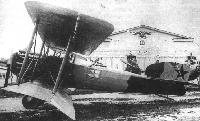 |
В.Кондратьев - Самолеты первой мировой войны
|
"Бреге 14"В.2 советских ВВС. На самолетах сохранился французский песочно-зеленый камуфляж
This Breguet 14 was flown by the French pilot Lacombe when captured on the Southern Front in 1919. Three Breguet 14s were used by the RKKVF.
|
 |
В.Кондратьев - Самолеты первой мировой войны
|
| "Бреге" Br.14 в составе ВВС РККА
|
 |
H.Cowin - Aviation Pioneers /Osprey/
|
| Although more workmanlike than beautiful in their appearance, the Breguet Bre 14 series of two seaters was deservedly destined to become the standard French long-range reconnaissance and day bomber during the closing year of the war. Almost directly contemporary and certainly comparable to Britain's Airco DH 4/DH 9 series, the prototype Bre 14 first flew in November 1916 and following the completion of testing was ordered into quantity production for the French in March 1917. Initial operational deployment followed in September 1917. Powered mainly by the 300hp Renault, the shortage of these units sometimes led to the use of the 300hp Fiat A.12bis engine, the Bre 14A, seen here on the ground, was the reconnaissance version, with the Bre 14B being the bomber variant. While both versions had a top level speed of around 121mph at sea level, the operational ceiling of the lighter loaded reconnaissance machine was 19.000 feet, while that of the bomber, with its up to 580lb bomb load and heavier defensive fire power of four, instead of three .303-inch guns, was reduced to 14,000 feet. The bomber, with its full load range of 280 miles, cruised at around 95mph. For short-range night missions, the Bre 14B could carry up to a 1,080lb bomb load. Belated as it was, the arrival of the Bre 14B was to be welcomed by French bomber crews, as it finally ended the all-too lengthy period during which successive French bomber designs had almost invariably proven inadequate to their task. The Bre 14, successor to the French-built Sopwith 1 1/2 Strutters, proved quite capable of being flown aggressively. Ernst Udet, Germany's second ranking fighter ace, nearly lost his life to one in March 1918. By the time of the Armistice, all French day bomber squadrons were operating Bre 14Bs, with no less than 55 French squadrons using the series. In addition to the French, the Bre 14 series was used by the Americans, who bought 290, along with the Belgians. Over 8.000 of the series were to be built in all, including considerable sub-contracted production by Darracq, Farman and Paul Schmitt.
|
 |
G.Swanborough, P.Bowers - United States Military Aircraft since 1909 /Putnam/
|
|
|
 |
H.Cowin - Aviation Pioneers /Osprey/
|
| The impressive low-level fly-past image seen here is of a Bre 14B.2 belonging to Escadrille BR III. Incidentally, the large transparent panel positioned under the observer's cockpit, on both sides of the fuselage, was the primary external means of identifying the bomber version from the 'recce' machines that lacked this feature.
|
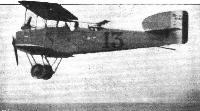 |
Журнал - Flight за 1919 г.
|
| An impression of the Breguet tractor biplane in flight.
|
 |
Сайт - Pilots-and-planes /WWW/
|
| Breguet 14 A2 with a Fiat engine in flight
|
 |
Сайт - Pilots-and-planes /WWW/
|
| Breguet 14 in flight. This aircraft carries the French five-color camouflage scheme
|
 |
Журнал - Flight за 1919 г.
|
| A Breguet tractor biplane about to land
|
 |
G.Swanborough, P.Bowers - United States Military Aircraft since 1909 /Putnam/
|
|
|
 |
H.Cowin - Aviation Pioneers /Osprey/
|
| Some aircraft types were bought directly from the French for use by the American Expeditionary Forces. One such aircraft being the fast, two seat Breguet Bre 14B day bomber. The one seen here belonged to the 96th Aero Squadron, with its emblem comprising a red devil clutching a white bomb, all framed by a white triangle. Formed early in 1918, the 96th Aero was declared operational on 29 May 1918.
|
 |
K.Delve - World War One in the Air /Crowood/
|
| The 96th Squadron was one of a number of Allied bomber units to operate the Breguet 14-B2.
|
 |
K.Delve - World War One in the Air /Crowood/
|
| Breguet 14 of the 96th Squadron being loaded with bombs at Amanty. 29 July 1918. Maj. J.L. Dunsworth is on the right.
|
 |
K.Delve - World War One in the Air /Crowood/
|
| The Breguet 14 A2 reconnaissance aircraft was powered by a 300hp Renault engine; the prototype first flew in November 1918 and the type went into large-scale production.
|
 |
K.Delve - World War One in the Air /Crowood/
|
| Breguet 14 A2 reconnaissance machine; over 5.500 Breguet 14s in reconnaissance and bomber variants had been built by the end of the war and production continued into the 1920s.
|
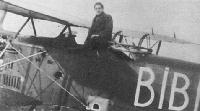 |
В.Обухович, А.Никифоров - Самолеты Первой Мировой войны
|
|
|
 |
Сайт - Pilots-and-planes /WWW/
|
| Breguet AV 1 prototype which was developed into the Breguet 14 via the Breguet AV 2
|
 |
Сайт - Pilots-and-planes /WWW/
|
| Breguet AV 1 prototype which was developed into the Breguet 14 via the Breguet AV 2
|
 |
Сайт - Pilots-and-planes /WWW/
|
| AV 1 , also designated the Breguet 13 by the STAe
|
 |
Jane's All The World Aircraft 1919 /Jane's/
|
| Breguet AV 2. This aircraft differed from the AV 1 by having a 275-hp Renault engine, a slightly longer fuselage, and a fixed fin
|
 |
Сайт - Pilots-and-planes /WWW/
|
| Breguet AV 2 which was the second prototype of the Breguet 14 series
|
 |
Журнал - Flight за 1918 г.
|
| Some aeroplanes of the Fifth Army of France: Breguet A V.
|
 |
Сайт - Pilots-and-planes /WWW/
|
| The Breguet AV 2 fitted with balanced ailerons
|
 |
Сайт - Pilots-and-planes /WWW/
|
| Breguet 14 A2 of BR 209 which was assigned to the 3rd Armee. The escadrille's insignia was a cockatoo
|
 |
Сайт - Pilots-and-planes /WWW/
|
| Breguet 14 A2 of BR 220. Pilot is Serrant, observer Dreyfus. The machine gun mounted on the top wing is a field modification
|
 |
Сайт - Pilots-and-planes /WWW/
|
| Breguet 14 A2 serial 779 of BR 202 named Gabrielle
|
 |
Сайт - Pilots-and-planes /WWW/
|
| Breguet 14 A2 at hte airfield of No.4 Squadron AFC, 1918
|
 |
Сайт - Pilots-and-planes /WWW/
|
| Breguet 14 A2 serial 9060 which was fitted with a Liberty engine
|
 |
Сайт - Pilots-and-planes /WWW/
|
| Breguet 14 B2 serial BR 13005 of BR 134. The observer's windows were on either side of his cockpit. This late Michelin-built machine lacks the trailing-edge flaps on the lower wing. The engine is a Liberty
|
 |
Сайт - Pilots-and-planes /WWW/
|
| Breguet 14 A2 serial 16156 with the Breguet Moreux radiator
|
 |
Сайт - Pilots-and-planes /WWW/
|
| Breguet 14 A2 serial 16156 with a Renault engine and a Breguet Moreux radiator
|
 |
Сайт - Pilots-and-planes /WWW/
|
| Breguet 14 B2 of the 96th Aero Squadron of the 1st Day Bombardment Group
|
 |
Сайт - Pilots-and-planes /WWW/
|
| Breguet 14 A2 of the 96th Aero Squadron of the 1st Day Bombardment Group
|
 |
Сайт - Pilots-and-planes /WWW/
|
| Breguet 14 of the 96th Aero Squadron of the 1st Day Bombardment Group in flight
|
 |
Сайт - Pilots-and-planes /WWW/
|
| Two Breguet 14 A2s of the 96th Aero Squadron of the 1st Day Bombardment Group
|
 |
Сайт - Pilots-and-planes /WWW/
|
| Breguet 14 A2 of the 96th Aero Squadron with a model of the Breguet 14 on the wing
|
 |
Сайт - Pilots-and-planes /WWW/
|
| Breguet 14 A2 Jane IV of BR 209 flown by Capitaine De La Motte Ango De Flers in 1917
|
 |
Сайт - Pilots-and-planes /WWW/
|
| Breguet 14 A2 Jane IV
|
 |
Сайт - Pilots-and-planes /WWW/
|
| Breguet 14 B1 intended for Jules Vedrine's proposed raid on Berlin. However, the aircraft's range proved to be too marginal for the task and the raid was canceled
|
 |
Сайт - Pilots-and-planes /WWW/
|
| Breguet 14 B2 serial BR 1102 with Michelin bomb racks underneath the wings. This is an early Michelin-built machine. The fuselage windows are lower on the fuselage than on later machines
|
 |
Сайт - Pilots-and-planes /WWW/
|
| Breguet 14 B2 serial BR 1102
|
 |
K.Delve - World War One in the Air /Crowood/
|
| The Breguet 14 B2 prototype was introduced in the French forces in April 1917 as a bigger-winged variant of the successful 14 A2. The bomber variant was given racks under the wings for 32 small-calibre bombs.
|
 |
Сайт - Pilots-and-planes /WWW/
|
| Breguet 14 B2 fitted with a 380-hp Liberty engine
|
 |
Сайт - Pilots-and-planes /WWW/
|
| Breguet 14 B2 serial 4599 showing its 300-hp Renault engine
|
 |
Сайт - Pilots-and-planes /WWW/
|
| Breguet 14 B2 serial 12079 of BR 123 showing a full complement of 50-kg and 75-kg bombs. The crewmen are identified as the Peyerimhoff brothers. This aircraft was built by Michelin
|
 |
J.Herris - DFW Aircraft of WWI /Centennial Perspective/ (29)
|
| DFW C.V at Cheb airfield at the Czech Air Force School about 1921. A Breguet 14 is in the left background.
|
 |
J.Herris - AEG Aircraft of WWI /Centennial Perspective/ (16)
|
| Flieger Abteilung (A) 208 lineup at Voyenne in the Spring of 1918 shows a variety of two-seaters with that unit's reverse swastika marking on their fuselages, including an AEG J.I at center.
|
 |
J.Herris - AEG Aircraft of WWI /Centennial Perspective/ (16)
|
| A closeup of the above photo of Flieger Abteilung (A) 208 shows the AEG J.I at right, with a captured Breguet 14 at left. Was the AEG J.I at right Margo as shown in the photo on the previous page?
|
 |
J.Herris - LVG Aircraft of WWI. Volume 3: Types C.VI-C.XI & Fighters /Centennial Perspective/ (36)
|
| LVG C.VI 8945/18 photographed in US possession at Trier postwar. A Breguet 14 is in the hangar at far right.
|
 |
C.Owers - Hansa-Brandenburg Aircraft of WWI. Volume 1 - Landplanes /Centennial Perspective/ (17)
|
| Line-up of Czech aircraft. Five C.I type biplanes and a solitary Breguet 14 are in the line-up. Note how the front and rear cockpits have been joined into the one opening on the first machine.
|
 |
J.Herris - LVG Aircraft of WWI. Volume 3: Types C.VI-C.XI & Fighters /Centennial Perspective/ (36)
|
| Three aircraft photographed inside the OSOL Toruh hangar. At front LVG C.VI Polish no. 550/18 with hand painted camouflage at fuselage, next LVG C.VI 1505/18 with mount for photo camera at the side of the fuselage and last Breguet XIV B2, Polish no. 10.47 with similar mount at side of the fuselage. (Piotr Mrozowski)
|
 |
J.Herris - Zeppelin-Staaken Aircraft of WW1. Vol 2: R.VI R.30/16 - E.4/20 /Centennial Perspective/ (48)
|
| Staaken R.XIVa lined up with Nieuports and Breguets, probably in the Ukraine. In 1919 the German Government allowed DLR to charter a number of aircraft to the Ukraine Government for the transportation of new money for the young state [that the Germans were printing clandestinely]. The Ukraine was at war with Rumania and Poland and wanted to stimulate its economy by introducing a new currency. Some of the DLR aircraft were secretly transferred to the Ukraine and in addition the Ukraine Government chartered the three five-engine Staaken R.XIVa aircraft from DLR. These aircraft had serial numbers R.69, R.70, and R.71 and registration D.129, D.130, and D.131 respecitively. All three were lost. The first, R.69, was confiscated on 29 July by French troops on behalf of the IAACC at the airport of Wien, Aspern. R.71 crashed and burned on 4 August in Oberschlesien. The last Staaken R.XIVa, R.70, commanded by Captain Count Hans Wolf von Harah and with pilots Heinrich Smiltz and Henrig Tretken, was forced down due to fuel problems on 19 September on its way to Kamenets-Podolski. Upon landing the crew was captured by two soldiers of the Rumanian 37th Infantry Regiment. On board the Rumanians found 303 million Griverns (Ukraine roubles), issued 5,6, and 24 October 1918. The Ukraine passengers were sent to a Ukraine-controlled area on the other side of the river Dnestr, while the Germans were imprisoned. The aircraft was repaired by Rumanian aeronautical engineers and flown by Petre Macavei (Technical 1st Lieutenant) and other crew members to the capital of Rumania, Bucharest. On its way the engine caused more trouble, but in the end the aircraft managed to arrive safely. It never flew again, but was stationed at the airport for several years before it was dismantled. Its wooden propellers went to the military museum in Bucharest. Without aircraft, the DLR had to supply new aircraft and offered the Friedrichshafen G.IIIa for Ukraine operations. (Peter M. Grosz collection/STDB)
|
 |
J.Forsgren - Swedish Military Aircraft 1911-1926 /Centennial Perspective/ (68)
|
| Although a very modern airplane, the sole Breguet 14 was rarely flown by the AFK due to its complicated fuel system. Via Arlanda Flygsamlingar
|
 |
--
|
| Photo from James Holland: I believe photos were taken between 1921 and 1924 at Hinaidi, Iraq.
|
 |
--
|
| Photo from James Holland: I believe photos were taken between 1921 and 1924 at Hinaidi, Iraq.
|
 |
В.Обухович, А.Никифоров - Самолеты Первой Мировой войны
|
|
|
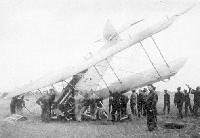 |
В.Обухович, А.Никифоров - Самолеты Первой Мировой войны
|
|
|
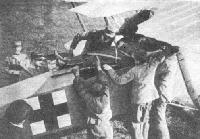 |
В.Обухович, А.Никифоров - Самолеты Первой Мировой войны
|
|
|
 |
В.Обухович, А.Никифоров - Самолеты Первой Мировой войны
|
|
|
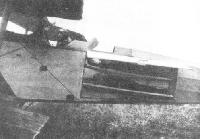 |
В.Обухович, А.Никифоров - Самолеты Первой Мировой войны
|
|
|
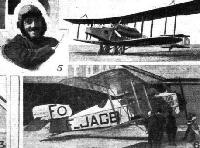 |
Журнал - Flight за 1919 г.
|
| LONDON-PARIS AND LONDON-BRUSSELS: The Handley Page firm are now running two continental air services, one to Paris and one to Brussels. In connection with the Paris service Breguet biplanes now alternate with the Handley Pages, the British machines leaving London on Tuesday, Thursday, and Saturday, the French machines on Monday, Wednesday, and Friday. The Paris-London service is in the reverse order. Our photographs show : (5) M. Patin, the pilot of one of the Breguet biplanes. (6) One of the Breguet biplanes alternating with the Handley Pages on the London-Paris service.
|
 |
H.Cowin - Aviation Pioneers /Osprey/
|
| Despite the massive popularity of the Bre 14 with land-based crews, the type was only built in small numbers in its Breguet Bre 14H floatplane form for the French Navy, who primarily employed it in the reconnaissance role. The enormous width of the central pontoon is clearly visible in this view.
|
 |
Журнал - Flight за 1919 г.
|
| The Breguet seaplane
|
 |
А.Шепс - Самолеты Первой мировой войны. Страны Антанты
|
| Французский легкий бомбардировщик Bre.14 и германский истребитель Фоккер Dr.1
|
 |
Журнал - Flight за 1919 г.
|
|
|
 |
Сайт - Pilots-and-planes /WWW/
|
|
|
 |
Сайт - Pilots-and-planes /WWW/
|
|
|
 |
Jane's All The World Aircraft 1919 /Jane's/
|
| Sectional Plan and Side Elevation of the Fuselage of the Breguet Biplane. Type 14 B.2.
|
 |
Jane's All The World Aircraft 1919 /Jane's/
|
| General Arrangement Drawing of the 14 B.2 as issued by the Breguet firm.
|
 |
В.Кондратьев - Самолеты первой мировой войны
|
| Breguet 14
|

